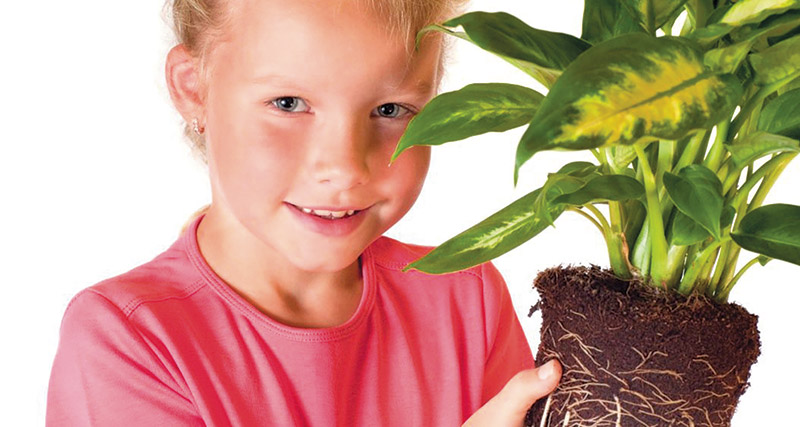Spending time in nature is so beneficial to our health and well-being. It calms us, reducing feelings of stress, anxiety and anger. It has also been shown to improve focus and attention, as well as lower blood pressure, heart rate, muscle tension and the production of stress hormones. It even makes us friendlier and more apt to reach out to others in our community.
Playing outside is one of the best activities for our kids, but what if it’s too cold or too rainy to go out? Is it possible to experience the benefits of nature from indoors? Nothing beats immersing ourselves in the natural environment outside, but science proves that we can capture the essence of what nature has to offer through images, sounds and plants inside our home.
Nature Imagery
Amazingly, just looking at pictures of nature scenes can make us feel similar to spending time outdoors. A recent study published in the International Journal of Environmental Research and Public Health found that you can reduce stress by merely looking at images of nature. When participants viewed pictures of natural scenes, their stress level decreased because their parasympathetic nervous system – which helps us to calm down – was activated.
Scientists have also proven that spending time in nature can make us feel more compassionate, connected to others and our environment. By observing brain activity using magnetic resonance imaging they discovered that when participants viewed scenes from the natural environment, the parts of their brain associated with empathy and love lit up. On the other hand, when they looked at urban scenes, the parts of the brain associated with fear and anxiety were activated.
Researchers at the University of Michigan conducted a study in which participants took 10-minute breaks in a quiet room to look at pictures of a nature scene or city street. Cognitive performance improved after the nature break. Although the boost was not as significant as when participants took a walk outside among trees, it was more effective than taking a walk in the city.
Nature Sounds
Listening to nature can help relax us and improve our mood. A research team at the University of Florida looked at how nature sounds affect people’s mental and physical health. They measured pulse rate, muscle tension and self-reported stress of a group of people and then had them listen to one of three sounds: silence, music by Mozart or ocean waves. Then the researchers gave the participants another medical exam and asked how stressed they felt.
There was no significant change for people who listened to silence or classical music, but those who listened to ocean waves had considerably lower muscle tension, heart rates and stress. These positive changes occurred quite rapidly – within five to seven minutes of listening to the sounds of nature. Imagine how quickly we can calm our children down by playing some soothing nature sounds!
Experts found, however, that not all nature sounds have the same calming effect. The best sounds are those that give a sense of natural space and mimic the biorhythms of an ecosystem like a forest. Loud chirping and croaking are not going to cause the same calming feelings as sounds of water, which are very soothing because of their slow, rhythmic whooshing noises.
Plants
Plants and flowers have long been known to cheer people up. Research done in hospitals, offices and schools has consistently found that even a single plant in a room can have a significant impact on reducing stress and anxiety. Plants boost healing, according to a study at Kansas State University. Researchers learned that viewing plants during recovery from surgery can lead to a significant improvement in physiological responses. Patients had lower blood pressure and less pain, anxiety and fatigue compared to patients who did not have plants in their rooms.
How to Bring More Nature Inside
How can we give our children experiences of nature on the days that we just can’t fit in outdoor play? Here are some ideas to expose your children to the fantastic aspects of nature from inside:
- Visit indoor sanctuaries of nature such as an arboretum, butterfly garden, botanical garden, greenhouse, science museum or aquarium.
- Decorate your house with awe-inspiring images of nature. Collect gorgeous pieces from famous photographers like Ansel Adams and Philip Hyde or start a family hobby of taking pictures of nature that you display throughout your house.
- Keep plants in your house.
- Start an indoor garden of herbs and flowers.
- Watch nature shows, movies and documentaries as a family.
- Include pictures and objects of nature that are green and blue in your house, colors known to calm us down.
- Play nature sounds in your home, especially at bedtime.
The beauty of nature is that it has the power to impact us no matter where we experience it. By giving our children a multitude of ways to observe nature, they can enjoy the many benefits it has to offer on any day of the year.
Posted in: Community
Comment Policy: All viewpoints are welcome, but comments should remain relevant. Personal attacks, profanity, and aggressive behavior are not allowed. No spam, advertising, or promoting of products/services. Please, only use your real name and limit the amount of links submitted in your comment.
You Might Also Like...

Love To Learn: Museums To Start The School Year
“Museum.” For some, this word piques excitement and interest. For many, it evokes bored childhood memories of hushed voices, slowly plodding steps, and the ever-constant scolding: “Don’t touch that!” If […]

Green & Clean & Laudable – Nominations for The Whole Earth and Watershed Festival Environmental Stewardship Awards Are Now Open
Do you know someone who is going above and beyond to help our planet be cleaner and greener? Do you know a teacher who is inspiring students to care for […]
The Crash Reel: Kevin Pearce’s Journey To Recovery
With the rising expectations of sports and the public’s desire to see athletes perform the most daring, seemingly impossible feats, the rate of sports-related brain injuries is increasing. A traumatic […]
Soroptimist International: Local Women Making a Difference in the North State
Valerie Sawyers-Stroud spent most of her life working things out on her own. For years, the single mom postponed the dream of pursuing her education so she could focus on […]




